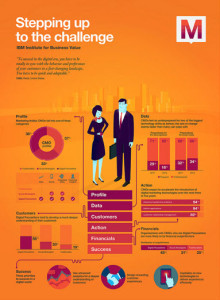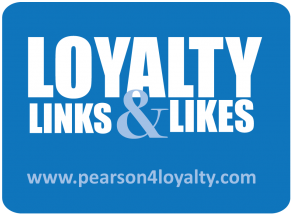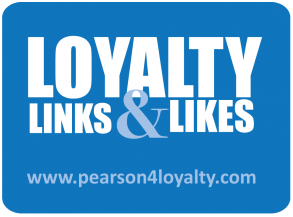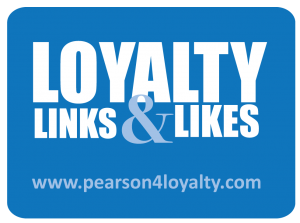Bryan Pearson's Blog, page 37
April 7, 2014
A Boutique Approach to Loyalty, in Four Steps
 When it comes to competing against low-priced giants, specialty shops should ignore the specials and focus on the personals.
When it comes to competing against low-priced giants, specialty shops should ignore the specials and focus on the personals.
This is among the key findings of a recent report by LoyaltyOne, “Four Ways to Win for Independent Retailers.” The study reports that 89 percent of those surveyed said personal recognition is the top area in which independent merchants outperform their competitors. That outweighs the leading competitive features of large chains (one-stop shopping, at 83 percent) and e-retailers (a mobile-friendly e-store, 68 percent).
Further, specialty retailers capture more than three times consumer spending than do online retailers. Twenty-seven percent of the Canadian shopper’s dollar is spent with specialty stores, compared with 8 percent at e-retailers.
Yet the specialty shop, even with frequent visits, lags sharply behind its large competitors. About two-thirds of Canadian shopping – 65 percent – takes place at major chains. The reason: Price. Almost half of the survey respondents identified money value as the reason for choosing large merchants.
But mom-and-pop shops would make a mistake to compete on price – and it could be a critical one.
What shoppers say they like about specialty merchants is personalization and the recognition that comes with one-to-one interactions. This is not something that a price tag can cover. Independents merchants have this edge over their large competitors, but there are several other areas in which they can improve if they want to capture big-box customers. The report lists these four:
Use the connection to learn: Forty-five percent of independent retailers said they have asked customers for their feedback, but only 30 percent of consumers think retailers have done so. This could be a coverage gap, or a failure in execution. Creative solutions, like offering incentives to those who provide feedback, can be combined with affordable technology such as cloud backup services that ensure customer information is securely stored and available for staff.
Curate, curate and be local: Survey respondents said they choose specialty shops not for quantity, but for quality. In fact, 42 percent of respondents said they feel overwhelmed by the choices at large merchants. Independent retailers should see their selection as an exclusive opportunity, offering items that appeal to the immediate geography. And speaking of geography, they should take advantage that their shoppers are more likely to support local suppliers.
Be more social: Shoppers are more likely to advocate an independent brand than a large one, so indie shops should be where word-of-mouth is most prominent, and that is social media. Sixty-seven percent of small merchants in the study reported a good return on investment from their social activity. But social media shouldn’t be approached willy-nilly. Merchants should choose the outlets that make the most sense, determine frequency that won’t be tiresome and be sure the messaging is more informative and collaborative than self promotional.
Reach, but stay local: While independent merchants capture a greater percentage of the wallet than do online merchants, they are not guaranteed to maintain it. More affordable technologies can enable merchants to operate an online store – even if just to carry a few best-selling items. And while effective loyalty programs can be complex to implement, merchants can seek partnerships with other businesses that do have a program in place. They can share the data and gain greater understanding of the customer both within and outside their stores.
It is easy to succumb to the temptation of price competition, especially when operating in the shadow of a major brand. But for independent merchants, the key to maintaining an edge is in ensuring that every new service and endeavor adheres to what makes them so special to begin with: personalization.
April 3, 2014
April 3: Loyalty Links & Likes
 1. Building A Successful Retail Loyalty Program – CMS Wire
1. Building A Successful Retail Loyalty Program – CMS Wire
Businesses are realizing that it is more important and profitable to focus on customer retention and building customer loyalty rather than expanding customer base.
2. Facts vs. Insights: How To Know You Have Truly Profound Customer Insights – Business 2 Community
The question many ask when helping marketing leaders recently is – how do we know we truly have profound insights?
3. The Race to Sensing In-Store Behavior – COLLOQUY
Manufacturers and retailers are in a foot race to capture the elusive behavior of the in-store shopper. New location-based technologies are getting it down, in some cases to the meter.
4. Study: Millenials Show More Brand Loyalty than their Parents – Brafton
Studying millenials and their habits offers insight into the changing marketing landscape as these technological early adopters mature and gain even more buying power.
5. Marketers Must Assume Control of Customer Experience – Marketing Week UK
CMOs must push to fully assume control of the customer experience as a responsibility for digital channels such as social media, e-mail and mobile messaging increasingly falls to marketing.
March 31, 2014
Great Time to Be a CMO, If You Are Among the 20 Percent
 Influence can be a magnificent vehicle in the C-suite, but if you are a chief marketing officer, you better make sure that vehicle is well powered or you risk hindsight that is more 80-20 than 20-20.
Influence can be a magnificent vehicle in the C-suite, but if you are a chief marketing officer, you better make sure that vehicle is well powered or you risk hindsight that is more 80-20 than 20-20.
This is the basis of two recent research reports, one by IBM and the other by Forrester. According to IBM, chief marketing officers are gaining significant influence with the corner office – 63% of CEOs involve the CMO in overall business strategies, second only to the chief financial officer at 72%. Yet only about 20% of CMOs feel fully prepared to manage the recent proliferation of data that is increasingly guiding their corporate decisions.
Similarly, Forrester finds that business leaders lack confidence in their digital strategies: while 74% said their company has a digital strategy, only 15% believe their company has the skills and capabilities to deliver on that strategy. This presents an opportunity for CMOs to step up – but at the risk of failing.
That CMOs feel ill prepared to tackle the burgeoning challenge should not be surprising. The average CMO likely rose through the organizational ranks before the complexities of mobile and social communications transformed customer relationship marketing into a global, around-the-clock necessity. The result is a lot of planning and intent, but limited action.
All of us are in a foot race to keep up with the rapid reproduction of big data. Based on my own experiences bridging the gap between customer information and customer intimacy, I’d suggest a four-step process:
1) Hire a data tamer: By next year, one quarter of large global organizations are expected to appoint someone to manage data oversight, according to research by Gartner. This could put companies without a chief data officer at a disadvantage. Companies should weigh this disadvantage against the investment in appointing someone to handle this critical success element as part of a broader strategy.
2) Say hello to the CIO: Once the data is well managed, the CDO and CMO should corral their ambitions and work closely with the organization’s chief information officer. Together, they can craft a roadmap to success that will get buy-in from the CEO and board.
3) Don’t drop the phone: The sheer volume of reports, articles and trade shows dedicated exclusively to mobile communications can waylay the urge to act on it. Savvy executives won’t make this mistake. Chief marketing officers, and the chief data officers, can combine their skill sets to extract the complex ways mobile will transform the customer experience – and how to tackle it.
4) We’re all at the starting line: Executives should embrace the potential of their data, and their strategies to execute on it, while recognizing that almost everyone is in the same place. A long-range plan, in combination with a series of “here-and-now” learning experiments that shape that plan over time, is a sound strategy for rounding the curve to future successes.
This four-step process is the engine that will accelerate a data strategy into action. It also will better position companies, and the people who run them, to more nimbly respond to other challenges.
(Image courtesy of IBM)
March 26, 2014
March 26: Loyalty Links & Likes
 1. Saying the “L Word” and Meaning It: How Marketers Can Improve their Loyalty Programs and Keep the Love Alive – Business 2 Community
1. Saying the “L Word” and Meaning It: How Marketers Can Improve their Loyalty Programs and Keep the Love Alive – Business 2 Community
In today’s fast paced world filled with short attention spans and catchy advertising tactics, customer loyalty can be forgotten (or stolen) in the blink of an eye.
2. Shock and Awesome: The Science Beyond Why Surprise Rewards Work and Who is Using Them – COLLOQUY
COLLOQUY explores the science behind surprise. Plus how MasterCard, Expedia and Caribou Coffee delight customers in unexpected ways.
3. Sportonomics: What Gear Makers are Doing with All That Data from Running Apps – The Toronto Star
Apps create sales and marketing value indirectly by creating a connection with the brand behind the app, and by encouraging users to run more, according to one marketing expert.
4. For True Brand Loyalty, Build Contextual Marketing Strategy Into Your Brand: Part 1 – Marketing Profs
No question about it, brand loyalty is down since the recession. Instead of choosing traditional routes to recover, something different is needed: a contextual marketing strategy to build brand loyalty.
5. Loyalty Programs for One-of-a-Kind Hotels – The New York Times
Travelers no longer have to choose between accumulating rewards and staying at boutique hotels, with many independent hotels joining programs like Stash and Voila!
March 24, 2014
Salesforce.com and Customers for Life: The Company You Keep

A lesson business owners and executives learn fairly early in their careers is that success is not found in what you make but in what you keep. This is true when it comes to revenue, and especially true when it comes to customers. Loyal customers reflect a brand’s integrity, reliability, and quality. In return, people behind the brand not only realize financial benefits but gain longtime customers who become partners and even friends.
This is the philosophy behind Customers for Life, a long-term customer support and life-cycle initiative of Salesforce.com., the pioneer and leading provider of enterprise cloud computing applications and platforms.
Customers for Life is a dedicated team delivering programs, technology, and strategy, focused entirely on retaining and increasing renewals with customers. The initiative enables customers to effectively adopt and leverage the Salesforce.com service—everything to sell, service, market, and innovate using its cloud platform. These customers, by having an active role in the process, in turn become advocates of the company.
Salesforce.com does this in three ways:
1. Listening: The company established IdeaExchange, a crowdsourcing forum where customers can suggest new enhancements, vote and comment on their favorite products, and interact with product managers and other customers.
2. Creating Community: To share the wealth of expertise and knowledge within its diverse customer base, Salesforce.com created the Salesforce Customer Community, an online gathering spot where clients can post questions, find training videos and learn best practices.
3. Keeping It Human: Special Customer Success Managers work closely with Salesforce.com customers, often strategically but also on a day-to-day operational level to ensure success and, in turn, a high adoption of its services.
With Customers for Life, Salesforce.com creates not only long-term client relationships, but advocates for life. This happens because Salesforce.com includes not only its own departments in the insight-sharing and decision-making process but also its clients. This kind of empowerment represents enterprise loyalty to the highest degree.To gauge results, Salesforce.com conducts a biannual worldwide survey, which in 2012 found that 95 percent of the respondents said they “definitely or probably” would continue using Salesforce.com, and 88 percent indicated they would definitely or probably recommend it to others. These outstanding results validate the program and provide input for future strategic direction.
Through the dynamic and relevant touch point mechanisms of the Idea Exchange and Customer Community, as well as the personalized service approach of Customer Success Managers, Salesforce.com is able to work closely with customers to gauge their progress against peer groups, find ways to increase adoption, and leverage its offerings to the fullest.
With this consistent exchange of information and ideas, Salesforce.com can identify its customers’ changing needs and goals, then make the necessary adjustments. Circling back to its foundational tools of listening, sharing, and coaching, it can regularly assess and ensure customer success, which is the achievement of their mutual goals.
This is a concept, and company, worth keeping.
Note: This blog post is an edited excerpt from The Loyalty Leap for BtoB: Turning Customer Information Into Customer Intimacy. The full Salesforce case study is included in the e-book.
March 19, 2014
March 19: Loyalty Links & Likes
1. Why Bother Shopping to get Supermarket Gas Rewards if You’re Going There on Foot?- Greater Greater Washington
Calling for grocery stores especially in urban areas to expand their rewards beyond just gasoline.
2. Ripped From the Headlines: At JetBlue, Loyalty is a Badge of Honor – COLLOQUY
Input from customers and crew creates clear sailing for the TrueBlue badges loyalty program.
3. Employees can play a key role in increasing customer loyalty - Retailwire
Getting employees more engaged in loyalty programs will help them do the same with customers.
4. Using Loyalty Programs to Lure Customers Away from Discounts- Business 2 Community
Luring shoppers with price cuts is short-lived and short sighted. More effective loyalty programs have longer-lasting benefits.
5. New Report Ranks the Best U.S. Companies in Customer Loyalty – Bulldog Reporter
Bank of America, Amazon, Zappos and Apple Among Leaders in report showing how Companies Position Themselves to Outpace Their Competitors to Increase Customer Retention and Acquisition.
March 17, 2014
Amex EveryDay: A Question of Partners vs. Dilution
 I remember the day I received my first American Express card as the day I had arrived. The card and its gladiator icon represented status, accomplishment and all of the milestones to which I aspired.
I remember the day I received my first American Express card as the day I had arrived. The card and its gladiator icon represented status, accomplishment and all of the milestones to which I aspired.
Now American Express wants to offer that aspirational experience to a broader group of customers. It has recently announced an Amex EveryDay card that charges no fee, but still offers its holders access to Amex’s Membership Rewards program and its perks for making everyday purchases.
It apparently comes with high hopes. American Express said the EveryDay card represents its biggest debut, investment wise, since it launched its “Blue” brand in 2000. Ed Gilligan, president of American Express, told Bloomberg Businessweek the company is trying to engage new kinds of customers – mothers for example would receive incentives such as extra points for shopping at supermarkets.
Experts have described the move as a bid to broaden American Express’ customer base and redefine the brand, which has long held the status of an upscale luxury card. But the strategy raises the question of why? Doesn’t expanding the American Express pool introduce the risk of diluting the brand’s exclusive image? (I should note here that American Express also will offer a $95-a-year EveryDay Preferred card with higher reward rates.)
Then there is the question of timing. With the reconfiguration of the Delta SkyMiles rewards system to dollars from miles, won’t some American Express SkyMiles members decide they get more value from a no-fee card than the fee-based frequent flyer card? Perhaps this is a strategy on American Express’ part to capture any such departing members – it’s better than losing them to a competitor.
I guess the answer is in whether that risk is offset by the opportunity to expose American Express customers to a broader universe of partners. One of the card’s features is members who make 20 or more purchases in a billing period earn 20 percent extra points on all those purchases. That encourages lots of small purchases, which means customers will start using the card in places they otherwise would not have.
And that means American Express partners benefit, as will American Express. An added bonus: the card has a built-in EMV chip, which provides better security than a magnetic strip. After the recent rash of retail data compromises, this could be a selling point for members and partners.
Today’s American Express card might not look like my first, but I guess it is looking a lot more like the industry, and the consumer market, in which it competes.
March 12, 2014
March 12: Loyalty Links & Likes

1. Why Are Building Employee Loyalty and Getting on a “Best Places to Work” List a Marketer’s Dream? - Business2Community
For executives who sincerely want to improve their company’s performance, improvement in employee loyalty alone is a guaranteed profit and growth builder.
2. Ripped From the Headlines: Amex’s Top 10 Loyalty Lessons – COLLOQUY
A look at experts in media, entertainment and sports for insights into how companies can turn potential customers into fans and loyal brand advocates.
3. Making Loyalty Data Useful Across the Company – Marketing Interactive
Loyalty programs have the potential to become a center of useful, practical insights for the entire business and not just the marketing department.
4. How Mobile Apps Can Nurture Brand Loyalty: Stories from SXSW – Marketing Land
Brands may think they’ve got it made when they’ve enticed a customer to download and install their mobile app, but there’s so much more opportunity when it comes to nurturing customer loyalty.
5. Reasons Why Small Businesses Are Turning To Mobile Loyalty Programs – Business2Community
Loyalty programs have been around for a long time now, but mobile loyalty programs are growing very quickly, as more and more small businesses put them in place.
March 10, 2014
The Rise, and Rise, of the CDO
I once wrote that one of a business leader’s most valuable assets is also the least likely to be quantified. How does a chief accountant measure what inspires a customer?
The answer, I now am finding, is that the chief accountant does not. Rather, a new role is being created for that job – the chief data officer – and it may become one of the most important positions in the c-suite.
Consider that Americans are enrolled in more than 2.65 billion loyalty programs – 22 per household – but participate in less than half, according to loyalty researcher COLLOQUY. As marketers, we strive to engage consumers, but still have no hard evidence of their underlying commitment to our brands and services; no formula that measures bottom-line growth or cash flow can reveal customer loyalty.
But that may change, according to recent research by Gartner. The information technology consultant predicts 25 percent of all large global companies will have someone dedicated to the role of data oversight by next year. Here are five facts Gartner shares about these CDOs:
The role is growing to the power of 10: More than 100 chief data officers – that specific job title – work at large organizations today. That’s more than double the number Gartner counted in 2012.
Finance and government lead the way: The role of the chief data officer is most prevalent among banking, government and insurance entities, in that order. That said, Gartner is now seeing an uptick of CDOs in other industries.
Most are in the United States: While there are now chief data officers in more than a dozen countries, most of them – 65 percent – are in the United States. The United Kingdom accounts for 20 percent.
New York and the capital corner the U.S. market: More than a quarter of U.S. chief data officers work in New York or Washington, DC, not surprising since the government is a leading employer. Increased regulatory scrutiny is fueling the trend.
Women are major players: More than 25 percent of chief data officers are women. That compares with just 13 percent who are chief information officers. (I may have a talk with my daughter.)
These five facts converge to point out one truth: Data is among the most valuable of corporate assets today. It should be treated with the same care and scrutiny as product inventories and SG&A expenses.
By appointing a chief data officer, these organizations are shifting the corporate conversation from the analytics group to the boardroom, and eventually to the front lines where consumer is. When it comes to corporate assets, nothing beats that.
March 5, 2014
March 5: Loyalty Links & Likes

Here are a few loyalty links that caught my eye this week.
1. Grocery, Quick Service Chains Provide the Best Customer Experience - SmartBrief Food
Learn why supermarkets and quick service chains deliver when it comes to customer experience.
2. Which Membership Pays Off Faster: AAA or Amazon? – CNBC
What should consumers take into consideration when committing to annual memberships? See if the benefits represent real savings and how long it will take to reach the break-even point.
3. Delta’s Rewards Shift Puts Price on Messaging – COLLOQUY
How Delta devised a communication strategy to announce major changes to the SkyMiles frequent flyer program.
4. Sports and Loyalty Marketing Help Papa John’s Bring in the Dough – Chief Marketer
A spotlight on how a pizza chain has aligned mobile, social and traditional marketing channels to better target its core customers.
5. Talking Shop: Kroger Mobile Leadership Takes Loyalty to New Level – Just-Food
How U.S. grocer Kroger plans to leverage digital marketing to bridge the gap between online engagement and in-store purchases.
Bryan Pearson's Blog
- Bryan Pearson's profile
- 4 followers





